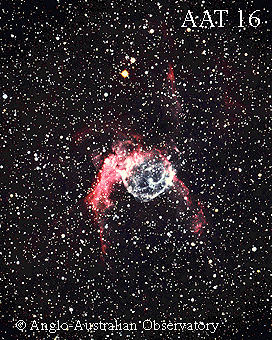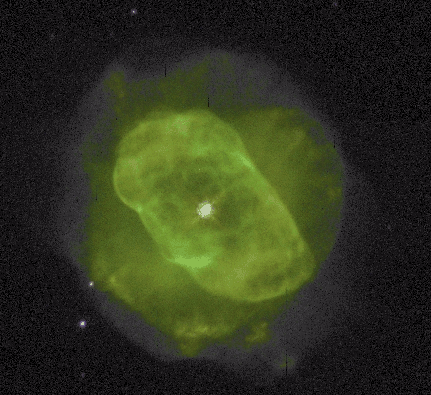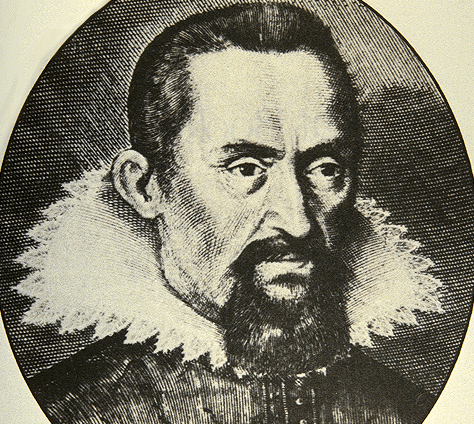NASA APOD #434-441
#434 Tomorrow's picture: August 26, 1996
“What's a Wolf-Rayet star, and how did it create that spherical bubble and sweeping arc? A Wolf-Rayet star is a star that originated with a mass over 40 times that of our Sun. An extremely hot, luminous star, it has since expelled shells of material through its strong stellar wind which could account for the bubble shaped nebula that surrounds it. But astronomers are unsure how the central Wolf-Rayet created both the bubble and the arc seen above, and even whether it acted alone in doing so. Together, this bubble and the arc are known as NGC 2359."
Copyright: Anglo-Australian Telescope
Board
#435 Tomorrow's picture: August 27, 1996
“What does the largest storm system ever recorded look like close-up? This storm system is Jupiter's Great Red Spot and it was captured recently in detail by the robot spacecraft Galileo now in orbit around Jupiter. Using real images from three color filters, the Galileo team was able to compute what a person would see if able to float just above this ancient rotating cloud system. But don't get too close - remember that Jupiter's Great Red Spot is a cold, high pressure area more than twice as wide as planet Earth."
Copyright: Public domain
#436 Tomorrow's picture: August 28, 1996
“Will most stars one day look like this? Pictured above is the planetary nebula NGC 5882, captured by the Hubble Space Telescope. Although planetary nebulae can appear similar to planets like Uranus and Neptune, they are actually gas clouds surrounding stars typically hundreds of light years away. Planetary nebula form when a typical star completes fusion in its core and ejects an outer envelope of gas - usually about 10 percent of the star's initial mass. This gas shell dims in about 50,000 years - short compared to the lifetimes of stars. Therefore, although only about 1000 planetary nebula are known in our Galaxy, it is thought that most stars go through this phase. Green light is emitted when oxygen ions acquire electrons from the surrounding gas."
Copyright: Public domain
#437 Tomorrow's picture: August 29, 1996
“What unusual eggs have been laid by this majestic swan? The star forming region above, known as Swan Nebula, is the home of hot red-glowing gas, dark lanes of dust, bright young stars and -- what are those? Of the few stars visible in the Swan Nebula, several have quite unusual colors and are hypothesized to be very young stars still shrouded by gas from the cloud that formed them. The Swan Nebula is quite large and massive as it contains roughly 1000 times the mass of our Sun. The bright central region is about 15 light years across lies about 5000 light years away toward the constellation of Sagittarius. The distinctive shape causes this region to have several other names, including the Omega Nebula, the Horseshoe Nebula, and the Lobster Nebula."
Copyright: B. Wallis and R.
Provin
#438 Tomorrow's picture: August 30, 1996
“Galileo Galilei made a good discovery great. Upon hearing at age 40 that a Dutch optician had invented a glass that made distant objects appear larger, Galileo crafted his own telescope and turned it toward the sky. Galileo quickly discovered that our Moon had craters, that Jupiter had it's own moons, that the Sun has spots, and that Venus has phases like our Moon. Galileo, who lived from 1564 to 1642, made many more discoveries. Galileo claimed that his observations only made sense if all the planets revolved around the Sun, as championed by Aristarchus and Copernicus, not the Earth, as was commonly believed then. The powerful Inquisition made Galileo publicly recant this conclusion, but today we know he was correct."
Copyright: Public domain
#439 Tomorrow's picture: August 31, 1996
“Johannes Kepler used simple mathematics to describe how planets move. Kepler was an assistant to the most accurate astronomical observer of the time, Tycho Brahe. Kepler was able to use Brahe's data to show that planets move in ellipses around the Sun (Kepler's First Law), that planets move proportionally faster in their orbits when they are nearer the Sun (Kepler's Second Law), and that more distant planets take proportionally longer to orbit the Sun (Kepler's Third Law). Kepler lived from 1571 to 1630, during the time of discovery of the telescope. Kepler was one of the few vocal supporters of Galileo's discoveries and the Copernican system of planets orbiting the Sun instead of the Earth."
Copyright: Public domain
#440 Tomorrow's picture: September 01, 1996
“What is the largest telescope in the world? In the optical, this title was long held by the Hale 200-inch, and is presently held by the Keck telescopes in Hawaii. But an even larger optical telescope is being built. Dubbed the Very Large Telescope (VLT), the European Southern Observatory (ESO) is building four 8.2-meter mirrors in Chile which together will act as a single telescope with a mirror diameter of over 16-meters. The first of these telescopes should be completed in 1997, and all four should be completed and working together sometime in the year 2000. The VLT will use active optics to create sub-arcsecond resolution. This, combined with the enormous light-gathering power, will allow astronomers to explore dim objects in our Galaxy and the early universe."
Copyright: European Southern Observatory
#441 Tomorrow's picture: September 02, 1996
“Sirius is the brightest star in the night sky. Intrinsically, Sirius is over 20 times brighter than our Sun and over twice as massive. As Sirius is 8.7 light years distant, it is not the closest star system -- the Alpha Centauri system holds this distinction. Sirius is called the Dog Star because of its prominence in the constellation of Canis Majoris (Big Dog). In 1862, Sirius was discovered to be a binary star system with a companion star, Sirius B, 10,000 times dimmer than the bright primary, Sirius A. Sirius B was the first white dwarf star discovered, a type of star first understood by Subrahmanyan Chandrasekhar in 1930. While studying Sirius in 1718, Edmond Halley discovered that stars move with respect to each other. The Sirius system is shown above captured in X-ray light."
Copyright: University of Leicester
Upvote! Resteem! Comment! As you like it! Thank you for attention!







